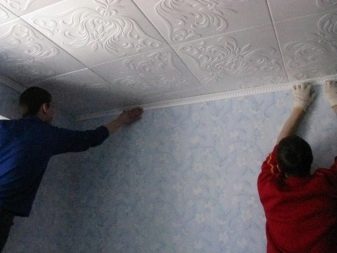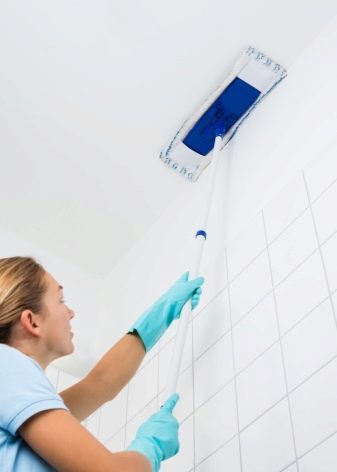How to glue foam ceiling tiles?

Among all the coatings used for decorative ceilings, foam tiles are increasingly prominent. And this is quite natural, since it has a democratic cost and a very effective appearance. The ease of installation also deserves attention: it is not difficult to glue the ceiling tiles, everyone who is not too lazy to familiarize themselves with the recommendations listed below will cope with this task.


Peculiarities
The materials from which such products are made are foamed polymers, also called cellular. Due to the peculiarities of their structure, they allow to provide high sound and thermal insulation of the equipped premises, making the home more comfortable.
Another significant feature of foam tiles is its lightness, which allows you to carry out almost all the necessary work alone (with the exception of marking, which is desirable to be done with a partner).


It should also be noted the variety of foam ceiling tiles.
They can take various forms, which can be:
- rectangular (the most popular is its square variation);
- diamond-shaped;
- hexagonal.


As for the surface of such products, it can be normal and laminated, smooth and embossed. In addition, many foam panels have an original color that imitates wood, stone, stucco, fabric and other materials. The choice of the most suitable type of stove depends on the taste preferences of the owner of the home, as well as on the specifics of the room. In particular, it is better to cover the kitchen ceiling with laminated foam plates, and the use of waterproof panels is rightfully considered the best solution for the bathroom.

Material calculation and glue selection
Before proceeding with the procedure for pasting the ceiling with foam plates, you should decide on the required amount of this finishing material. To do this, it is necessary to divide two areas - the ceiling and the tiles, the first into the second. Considering that the products under consideration most often have dimensions of 50x50 cm, the area of each of them is 0.25 m².
It is also worth noting that it is necessary to add 10-15% to the obtained numerical value, acting as "insurance" in case of excessive consumption of material or its damage.


If the owner of the premises does not consider it necessary to calculate the specific number of required foam panels, it is reasonable for him to use an alternative solution:
- determine the area of the room by multiplying its length and width;
- add standard 10-15% to the result obtained;
- buy the calculated tile area in a specialized store.


There you can also buy glue, the composition of which is best suited for foam panels. It should be bought in accordance with the amount of finishing materials, based on the average consumption per 1 m². Experience shows that pasting a ceiling with an area of 24 m² requires the use of 400 ml of glue, and 450 ml is enough not only for this procedure, but also for the reliable fastening of the friezes. As for ceilings, the surface of which cannot be called perfectly flat, then it is best to glue the tiles to them with a finishing putty mixed with PVA building glue in a ratio of 5: 1.


Another point worthy of attention is the calculation of the total length of the purchased ceiling plinths.
This value is equal to the perimeter of the room, to which 5% should be added to compensate for the inevitable clipping.


Surface preparation and marking
The procedure before pasting the ceiling with foam panels is to thoroughly clean it. It provides for the removal of the previous finish, which can be wallpaper, tiles or whitewash, as well as cleaning the surface from various kinds of dirt. Further, the ceiling must be treated with a primer - a special compound that provides maximum adhesion and negates the likelihood of the spread of pathogenic microflora. Special attention should be paid to the largest irregularities and differences, if any.


Upon completion of the listed activities, you can begin to mark the surface - a task, the correct solution of which involves taking into account the location of the foam plates. The latter largely depends on the characteristics of the room: for example, longitudinal installation is great for small rooms, and diagonal - for large ones. As for the point, which is a reference point for the pasting being carried out, then most often its role is played by the center of the ceiling or the location of the chandelier.


The options presented assume the following actions:
- Longitudinal. This method is the most popular, which is primarily due to its simplicity. First, you need to choose a starting point (for example, the center of the ceiling), and then divide the surface through it into 4 parts by lines parallel to the walls. The result of this operation will be 4 squares or rectangles. From the same point, you need to start pasting the ceiling with foam panels.


- Diagonal. In this case, the marking is carried out in the same way as in the situation with the longitudinal arrangement of the plates, with only one difference. Each of the formed right angles, the vertex of which is the starting point, should be divided into 2 equal parts by means of the corresponding line - the bisector. This action shifts the styling by 45 °, which provides a diagonal arrangement of decorative elements.


If the center of the room acts as a reference point, then it must be found unmistakably. To do this, a pair of threads stretched from the diagonally located corners of the room is enough: the desired result will be the point at which they intersect.
It is advisable to mark the surface using a chopping line, trying to achieve the highest possible accuracy.


Mounting
Having completed the marking of the ceiling, the owner of the premises can proceed to the gluing procedure. If the panels look the same, you can glue them in any order, and in a situation where the tiles have a composite pattern, you must strictly adhere to the required pattern.
In addition, you need to consider the following rules:
- It is advisable to glue the ceiling with foam plates after turning off the power supply.
- To prevent the decorative elements from getting dirty, you need to work with them with gloves.


- There are different ways to apply glue to the back of a tile. In particular, this is done with a solid line or dashed lines, as well as in the center and corners of the ceiling plate. The optimal tool in such cases is a comb.
- It is advisable to apply the glue only to the foam panel, so as not to cover the previously created markings.
- It is necessary to start pasting from the chosen starting point - so that the corners of the 4 central tiles converge in it. If the fixture of the lamp is located in it, then the corresponding corners of the foam panels will have to be carefully cut.


- After aligning the slabs along the marked lines, they must be firmly pressed against the ceiling. In this case, excessive efforts are not required to be applied - in order to avoid the appearance of dents on the mounted decorative elements.
- Slabs for the last rows usually need to be cut to size. As soon as this procedure is completed, a control fitting of foam panels should be carried out. If the dimensions of the products correspond to the conditions of the task, you can start applying the glue.
- The slots that form at the edges of the ceiling after pasting it must be filled with cut-out fragments of the ceiling tile of the appropriate size.



It is also worth adding that all work must be carried out gradually, step by step equipping small areas of the surface. In addition, it is important to get rid of excess glue in a timely manner, "armed" with a slightly moistened rag.


Sealing and gluing friezes
Practice shows that sometimes the dimensions of ceiling tiles belonging to the same model may differ slightly. As a rule, such deviations do not exceed 1-2 mm, but this is also enough to displace the joints between the glued panels. In order to avoid such a misfortune, experts advise to mount foam plates at a small distance from each other - about 2 mm.
In the future, the seams need to be sealed with putty or acrylic sealant. matched colors for excellent gap masking and optimum grip. After drying, the created decorative surface can be coated with water-based paint, which allows you to hide any, even the smallest, errors.


The final event is gluing foam friezes on the ceiling. Like slabs, they can also boast a variety of design options, suggesting many shapes, shades and relief features.
If you highlight other points that are characteristic of foam ceiling skirting boards, then their list is as follows:
- Narrow friezes, decorated with not very striking ornaments, are most suitable for small rooms. With wide products, the situation is the opposite: it is advisable to use them in rooms with a significant area.


- You need to glue the friezes from the corners of the room, adjusting the length of the walls and using inserts.
- In order to accurately cut the ceiling plinth at 45 °, you must use a special carpentry device - a miter box.
You can glue friezes both before decorating the walls with wallpaper, and after - with the only difference that the first option assumes a higher accuracy of fitting the canvases. Finally, it remains to close all windows and doors in the room more tightly in order to minimize the movement of air flows.


Helpful hints
In order for the selected foam tile to meet all the expectations of its owner, experts advise taking into account the following:
- When choosing a finishing material, special attention should be paid to the quality of the edges: all the edges of the ceiling panels must be perfectly even.
- It is not worth deforming or cutting the edges of the foam boards. Following this advice will result in the least visible seams.
- The clearer the ornament and fine graininess of the tile, the higher its quality. No less important is the strength of foam panels: a product that does not break under its own weight is considered to be of good quality, if you take it from any of the corners.


- The ceiling of a small room will not seem too "heavy" if it is decorated with slabs with a small pattern.
- The choice of the diagonal version of pasting implies a greater consumption of material, but allows for a better perception - due to less noticeable seams and a visual increase in the surface.
- Foam panels are not highly resistant to mechanical stress. Given this circumstance, the tiles should be handled carefully - from the moment of purchase until the completion of all finishing work with its use.


In the future, the glued panels should be periodically wiped with a dry cloth or carefully vacuumed.But the use of aggressive chemical compounds must be abandoned - due to the fact that they can render decorative elements unusable.
Summing up, it remains to state that pasting the ceiling with foam plates can be performed without significant expenditures of time, money and physical strength. Taking into account the simple rules listed in this material is all that is required to achieve optimal results.


For information on how to glue foam ceiling tiles, see the next video.







The comment was sent successfully.